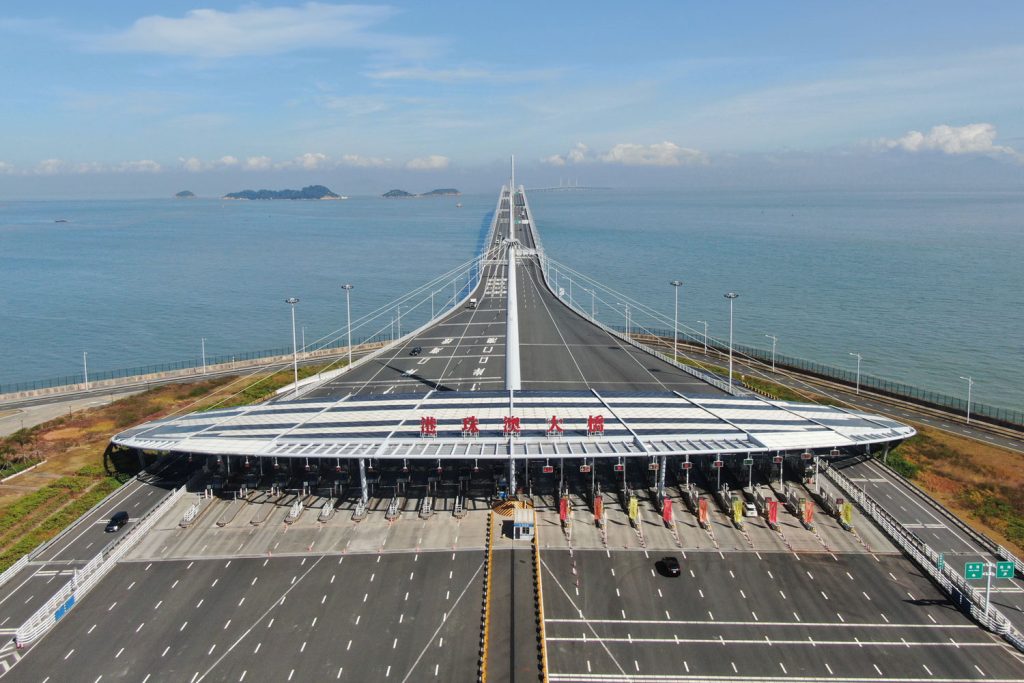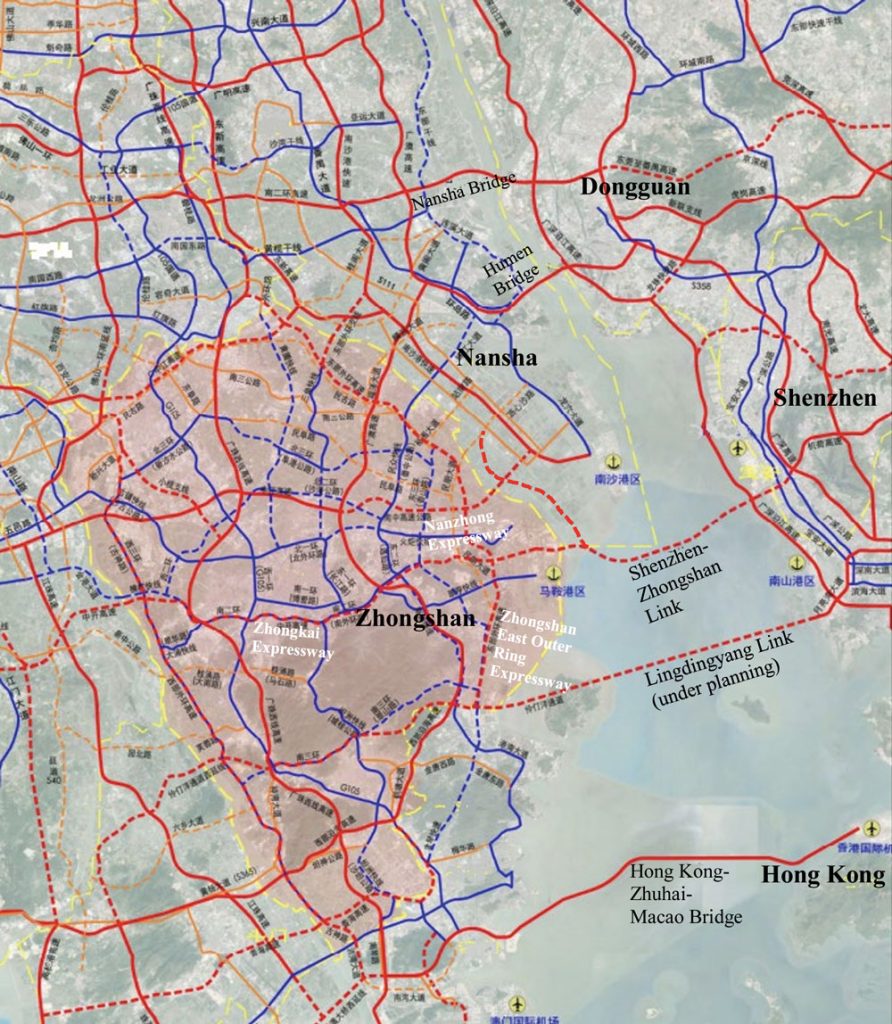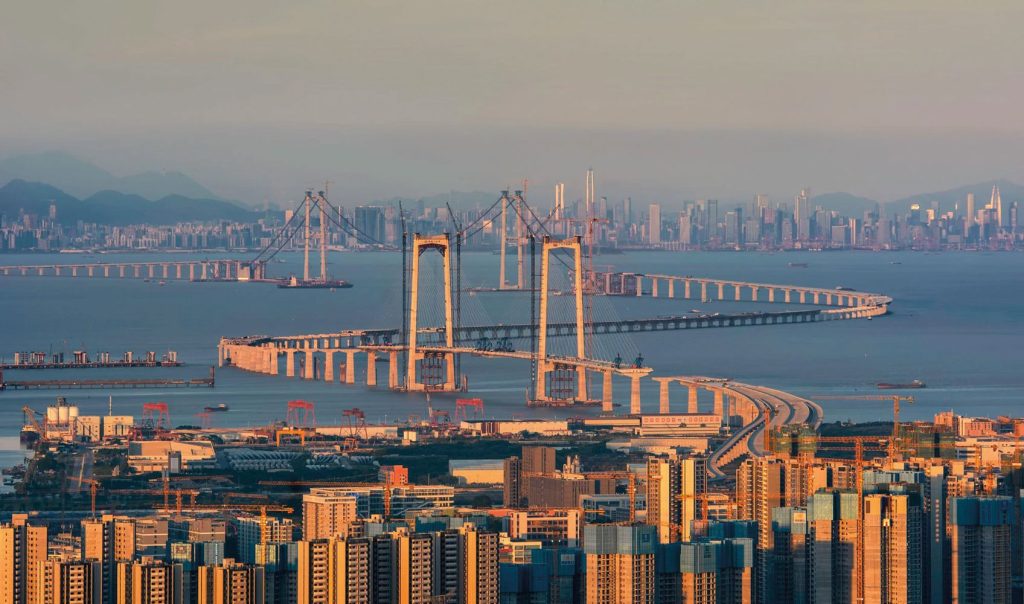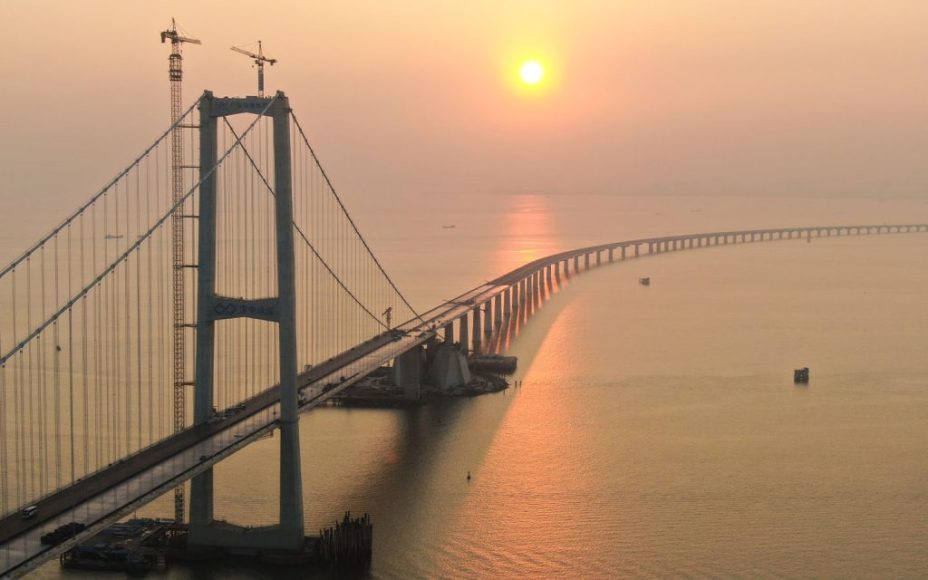In early 2023, the builders of the Shenzhen-Zhongshan Bridge set a world record. They paved more than 22,600 square metres of asphalt in a single day, about the same as five football pitches. This achievement represented more than a fascinating piece of trivia. It made China’s sizable ambitions in the Greater Bay Area (GBA) clearly known far and wide.
While it may not be the world’s longest bridge across the sea – that title belongs to the 55-km Hong Kong-Zhuhai-Macao Bridge slightly further south – the 24-kilometre, eight-lane Shenzhen-Zhongshan Bridge underscores the tantalising potential of the GBA. And the investment that the country is willing to make in order to realise it.
To date, the cross-sea highway project has been eight years in the making. It boasts two artificial islands and an underwater tunnel almost seven kilometres long. With the concrete poured and the roads paved, the bridge is nearly ready to open to traffic. When it does, the physical links between Shenzhen and Zhongshan – indeed, the entire GBA – will be stronger than ever.
Advancing economic growth

The GBA has been a focal point for the country for decades. The framework for a unified economic region in south China has existed since at least the early 2000s, although it was previously referred to as the Pearl River Delta. The union of the two Special Administrative Regions (SARs) – Hong Kong and Macao – with nine mainland metropolises enticed policy planners with its outward looking economic potential. When the country’s leaders unveiled the Guangdong-Hong Kong-Macao Greater Bay Area Development Plan in 2019, it was official recognition that the region’s moment had arrived.
The GBA is home to a collective population of 86.3 million people, spread across 11 cities – including Guangzhou and tech hub Shenzhen, home to the likes of Tencent, Shein and DJI Innovations. As such, the region has long played an outsized role in China’s economic contributions.
In 2023, the total economic output of the GBA came in at around 14 trillion yuan (15 trillion patacas). That was 11 percent of China’s gross domestic product, from a region that amounts to just 1 percent of the country’s land area and 6 percent of its total population.

The 2019 development plan laid out a vision to leverage the GBA’s strengths via a roadmap that would transform the GBA into a centre for technology and innovation. Notably, the country’s leaders declared that this development would be built around infrastructural connectivity. The announcement made sense: academics have spoken of the crucial role infrastructure plays in both China’s domestic and international development projects, most visible in its Belt and Road Initiative.
The nascent GBA’s first record-breaking infrastructural achievement actually opened before its development plan was unveiled, in the form of the Hong Kong-Zhuhai-Macao Bridge (known as the HZMB). Construction commenced in 2009 and the bridge opened at the end of 2018. Physically and symbolically, it united both SARs and the mainland. The first cross-boundary land link between the cities created a one-hour living circle in the Pearl River Delta, boosting tourism, finance and business. On 13 February this year, the fourth day of the Lunar New Year, more than 144,000 passengers used the HZMB – setting a new single-day record.
From the region to the world

Now, the country’s leaders believe the Shenzhen-Zhongshan Bridge could expand the GBA’s global impact. Bao’an International Airport in Shenzhen is the mainland’s third busiest airport, recording more than 50 million passenger trips in 2023, according to official data. Travel between the airport and Zhongshan used to take up to two hours by car, a 100-kilometre journey skirting around the Zhujiang River Estuary. The bridge will slash that time to just 20 minutes.
Links like these are increasingly vital to the region’s economy. Zhongshan is one of south China’s most important industrial centres.
In recent years, the city has set out to transform its industries, especially manufacturing. In the first quarter of 2024 alone, Zhongshan broke ground on 69 projects worth nearly 64 billion patacas collectively. Most are related to advanced manufacturing, including 5G integrated semiconductors and new-generation optical communications, according to Zhongshan officials.
The city is undergoing an industrial overhaul, with its business parks and science centres being renovated to foster new ideas and advanced products. With the new bridge in place, Zhongshan’s industrial developments are not only closer than ever to Shenzhen’s tech start-ups (a mutually beneficial situation), but to international markets as well.
Zhongshan is rapidly growing, and the city is seeking to expand job prospects and investment potential. At the Zhongshan Municipal High-quality Development Conference in February, the city made a full-throated recruitment pitch to global talent. More than 100 key enterprises and scientific research institutes in Zhongshan jointly called for over 1,100 talented individuals to start businesses in the city.
That same month, at the 2024 Zhongshan Talent Introduction Conference, the city welcomed more than 100 Chinese doctoral graduates from top global universities around the world – including Stanford, the Massachusetts Institute of Technology and Harvard in the US, and Oxford University in the UK. The conference encouraged China’s top talent not only to contribute back home, but specifically in the burgeoning GBA.
Investing in the future

From Zhongshan to Hong Kong to Macao, China’s historic hub of trade and commerce is looking to the future. Holding true to the belief that infrastructure can drive growth, the nine cities and two SARs that make up the GBA are witnessing tremendous developments that even include a game-changing new airport – the tentatively named Pearl River Delta Hub Airport (or Foshan Gaoming International Airport) in central Guangdong Province, which should have a passenger capacity of over 30 million by 2035.
When the Shenzhen-Zhongshan Bridge opens, it won’t just reduce travel times for car passengers. It will also lay the foundation for future growth across the GBA. The new bridge can unite the GBA like never before, drive development and transform entire industries. While there remain challenges to overcome, the opportunities are clear.



